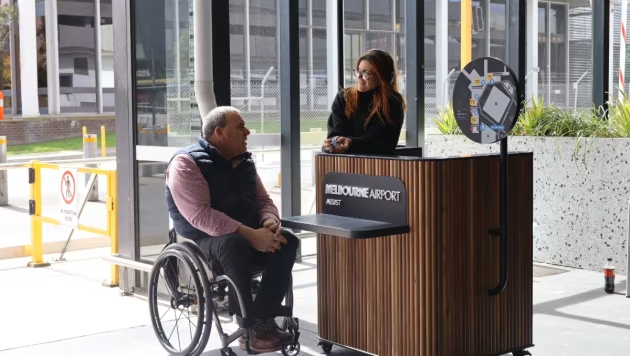Air travel is an anxious affair for many, but for people with disability the worries are multiplied. The Australian Government has produced an Aviation White Paper which highlights the difficulties people with disability experience travelling by air. For wheelchair users, the US Transport Board’s report found there is no engineering reason why power chairs can’t be secured in the aircraft.
Melbourne Airport trials disability access hubs
Beginning from September 2024, Melbourne Airport will trial a four-month Airport Assist program. The program will help passengers navigate the airport precinct, check-in and pick-up and drop-off zones.
The hub is open from 10am to 6pm and offers buggy transfers between T4 ground transport areas and departure areas. It will also have lanyard for the Hidden Disability Sunflower Program.

Air travel with a wheelchair
Wheelchair users can stay in their powered wheelchair in taxis, trains and buses, but not in aircraft. Every wheelchair user takes a deep breath and hopes their wheelchair will come through the flight without damage. The risk of personal injury in wheelchair to seat transfers is also a worry. The other inconveniences and indignities just add to air travel with a wheelchair.
Currently, people are potentially put on a flight in a seat that is not appropriate for them. Travellers and airlines risk injury in transfer and in flight. It also risks serious damage to their wheelchair which is set up for their individual requirements.

Preliminary research from the US Transport Research Board (TRB) found no major design or engineering challenges stand in the way of securing personal power wheelchairs in commercial aircraft. The TRB concluded that installing wheelchair securements is a win-win for wheelchair users, airlines, and everyone else involved in transporting wheelchair users. Consequently, that means it is up to the willingness of airlines to make the necessary changes.
No major design or engineering challenges stand in the way of securing power wheelchairs in commercial aircraft.
Transport Research Board.
Photo credit Heike Fabig (in Daily Mail)

Airport experience begins arrival kerbside
While there are mandates for minimum standards for the built environment, airport layout design make life difficult for people with disability and older people. Many airports were designed decades ago when traveller comforts were not considered. Arriving kerbside or at the drop-off is where the problems begin.
Assistance is not available outside the terminal entrance which becomes the first hurdle to overcome. In many instances, help is not available until check-in processes are complete. A kerbside or drop-off check-in would solve that. Or at least provide a means for travellers to contact service staff to help them from the kerbside point.
The US Airport Cooperative Research Program has a detailed report that identifies the issues and provides solutions. The title of the report is, Assessing Airport Programs for Travelers with Disabilities and Older Adults. The aim is to assist airport designers and airline operators to make their places and services accessible and inclusive. There are 8 chapters to the report.
Airport facilities
Chapter 7 of the report is about Facility Accessibility. It begins with access on arrival at the airport and the provision of accessible ground transportation. The advice for the design of terminals is to adopt a universal, inclusive approach. That includes addressing long distances between the key points for travellers who don’t use a mobility device.
Self-service kiosks, elevators, power outlets, seating and lighting, along with catering for people with a diversity of cognitive conditions are covered in detail. Case studies provide information about restrooms, adult sanitary change facilities, provisions for assistance animals, and quiet rooms.
August 2024 Update
The Commonwealth Government is proposing to update the transport disability standards to include aviation standards. The standards will require airlines to set up assistance profiles for passengers which lists what they need. The list could include things like wheelchair battery specifications and assistance animals. The two wheelchair policies will also be under review. A new Aviation Ombudsman will replace the industry-funded Airline Consumer Advocate. This information was taken from a Crikey article.
